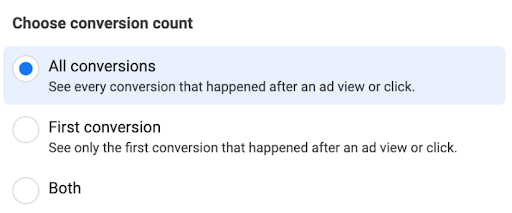If you’ve been struggling with conversion data in Meta Ads, you’re not the only one. But thanks to Meta’s recent ad attribution update, we expect to see a shift in the accuracy of Meta’s conversion attribution.
In this article, we’ll explain what’s new with the update and the impact we expect it to have on understanding your customers’ journey.
What’s Changed With Meta’s Ad Attribution Update?
Before July 2024, Meta contributed all conversions a user made after interacting with your ad to the same customer. Thanks to Meta’s ad attribution update, we’re now able to distinguish between all conversions and first-time conversions.
First Conversion only shows the first conversion that occurs after an ad view or click, excluding any subsequent conversions made by the same user.
All Conversions shows every conversion that occurs after an ad view or click, giving advertisers a better view of all conversions. This differentiation gives us a clearer picture of the impact of your ads on first-time conversions.
The Impact Of Improved Ad Attribution On Advertisers
Before the update, Meta’s ad data wasn’t accurately represented when we looked into our client’s data. It was found that Meta was counting about 25% of non-first purchases towards new customers, significantly inflating the reported performance metrics. This update aims to bridge that gap, providing more accurate insights into ad performance and customer acquisition.
Imagine your customer sees your ad and makes a purchase, but then makes multiple other purchases. Whilst the first conversion will give you a detailed insight into new customers, all conversions will give you a better idea of the overall picture of the entire buyer journey. Using the new feature together, as opposed to separate insights, will give us a better idea of your customer journey.
As another example, let’s say a user followed this set of conversion events over 7 days:
- View Content
- Custom Event (1-Minute View)
- Add to Cart
- View Content
- Custom Event (1-Minute View)
- Add to Cart
- Initiate Checkout
- Purchase
Depending on the conversion count that you select, you will see different data, as you can see below.
Conversion Type | All Conversions | First Conversion |
View Content | 2 | 1 |
Custom Event (1-Minute View) | 2 | 1 |
Add to Cart | 2 | 1 |
Initiate Checkout | 1 | 1 |
Purchase | 1 | 1 |
Where To Find Changes To Meta's Ad Attribution
If you’d like to explore Meta’s new attribution features for yourself, you can find them easily within your Ads Manager account.
To locate the settings:
Log in to Meta Ads Manager.
Navigate to the campaign, ad set, or ad you want to review.
Click on Columns in the reporting toolbar.
Select Customise Columns.
Under the “Attribution Setting” section, you’ll now see options to choose your preferred attribution window and conversion view.
Here, you can set:
Attribution Window: Choose a 1-day, 7-day, or 28-day click window, depending on how quickly you expect users to convert after interacting with your ad.
Conversion View: Select whether you want to see All Conversions, First Conversion, or Both.
If you select both, you’ll be able to compare side-by-side how many total actions your ads are driving versus how many are first-time conversions, giving you far richer insights into the effectiveness of your campaigns.

Importantly, changing these settings only affects how data is displayed in your reports; it doesn’t change how your campaigns actually run or impact real-time performance. It simply gives you more flexibility and transparency when analysing results.
If you’re managing multiple campaigns with different goals (such as prospecting and retargeting), we recommend reviewing both conversion views regularly to get a complete understanding of performance across the full customer journey.
Expected Trends
With the new update to Meta’s ad attribution model, we expect to see a significant shift in how advertisers approach campaign analysis and budget distribution.
First, we anticipate greater scrutiny on customer acquisition metrics. Previously, inflated reporting made it challenging to distinguish between genuine new customer conversions and repeat buyers. With clearer visibility into first-time conversions, advertisers will be better equipped to allocate spend towards campaigns that are genuinely driving new business rather than merely capitalising on existing customers.
Second, campaign optimisation strategies are likely to evolve. Brands will begin to place more emphasis on campaigns that nurture the entire customer journey, rather than simply focusing on initial acquisition. By understanding both first-time and all subsequent conversions, advertisers can refine retargeting efforts, loyalty programmes, and upselling strategies with greater precision.
Third, budget allocation across Meta and other platforms may shift. If advertisers find that Meta’s first conversion performance is lower than previously reported, they may choose to redistribute budgets toward platforms or strategies that show a stronger return on true new customer acquisition. On the flip side, improved clarity may also boost confidence in Meta campaigns that are genuinely delivering strong acquisition performance.
Finally, reporting and benchmarking practices will need to adapt. Businesses that previously relied on inflated attribution models will need to reassess KPIs and success metrics. Over time, we expect industry standards around paid media reporting to become more consistent and more closely tied to genuine customer behaviour, creating a more realistic foundation for long-term paid marketing strategies.
In short, this change pushes advertisers toward a more data-informed and customer-centric approach. It’s a positive step for the industry — but only for those prepared to act on the new insights it brings.
Ready to Strengthen Your Paid Marketing Strategy?
Navigating changes like Meta’s attribution update can be challenging without the right expertise. At Proof3, our paid specialists stay ahead of the curve, ensuring that every campaign you run is guided by the most accurate data available. Whether you want to improve customer acquisition, optimise your ad spend, or build a clearer picture of your customer journey, we’re here to help.
Get in touch with our team today to find out how we can refine your paid marketing strategy and unlock new growth opportunities.
About the author
Dan Hartill
Share this post
Read more

